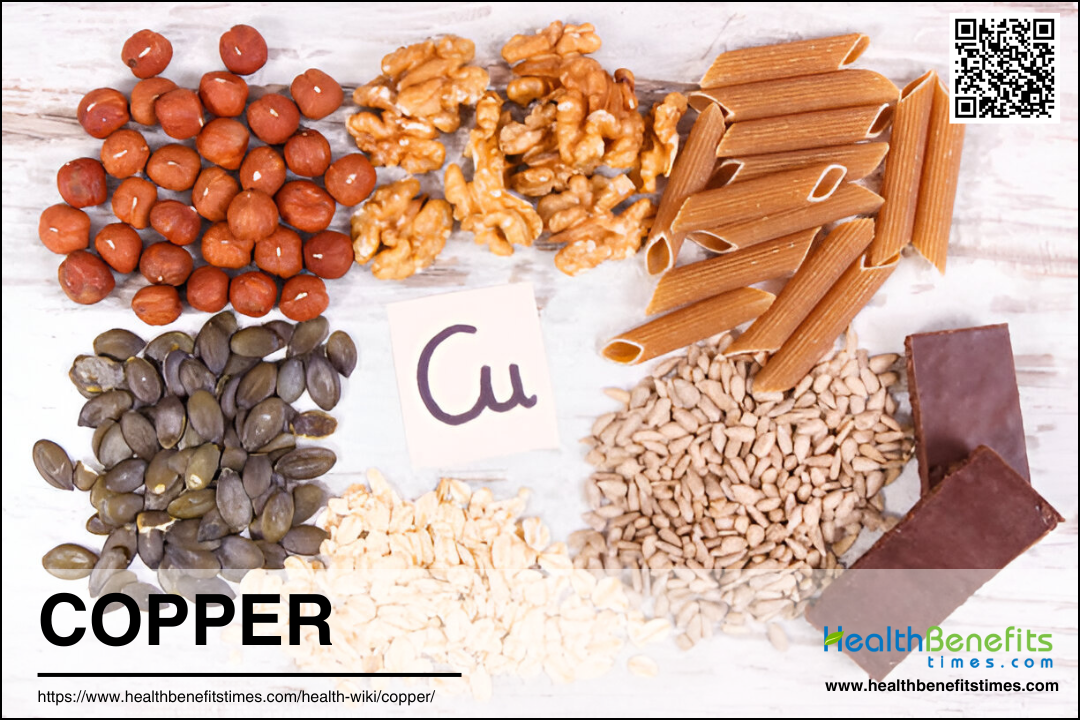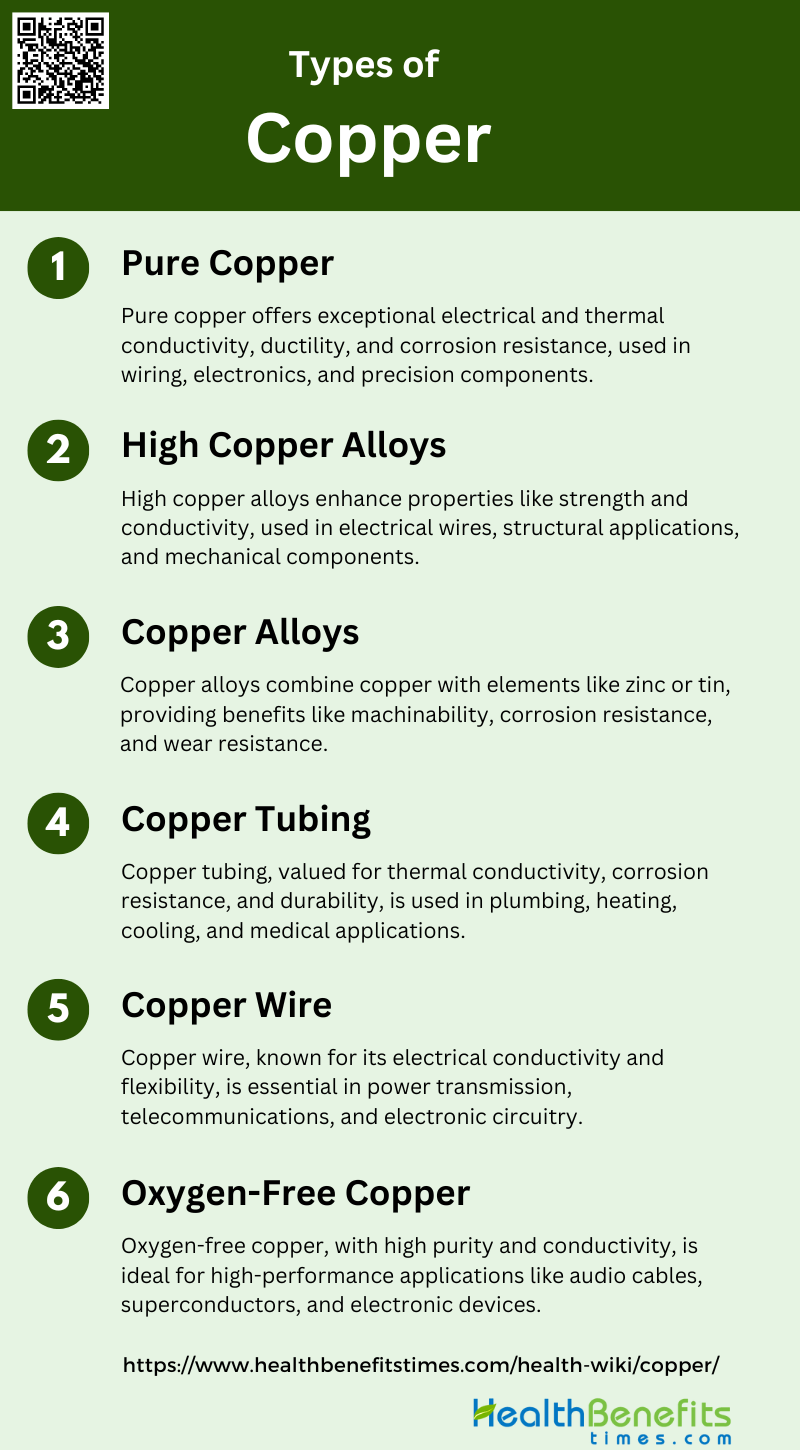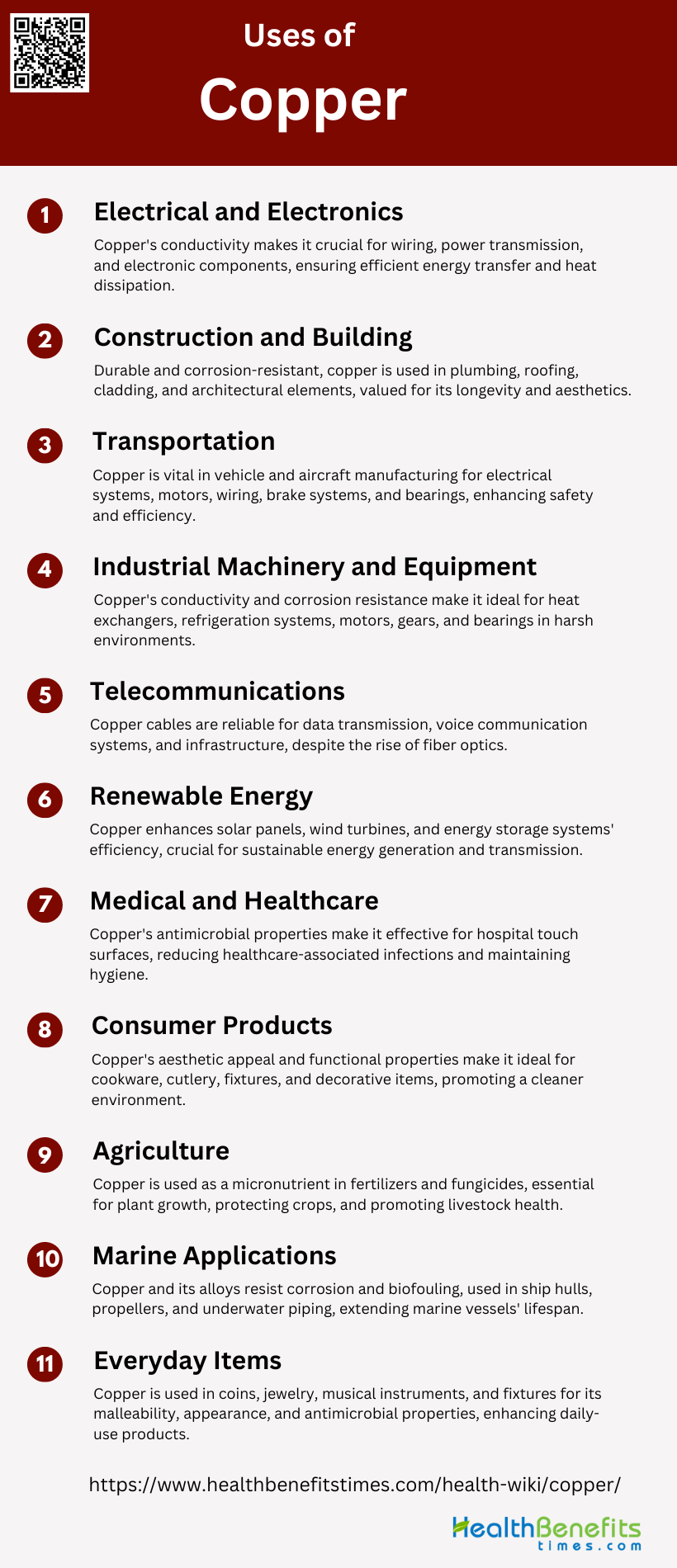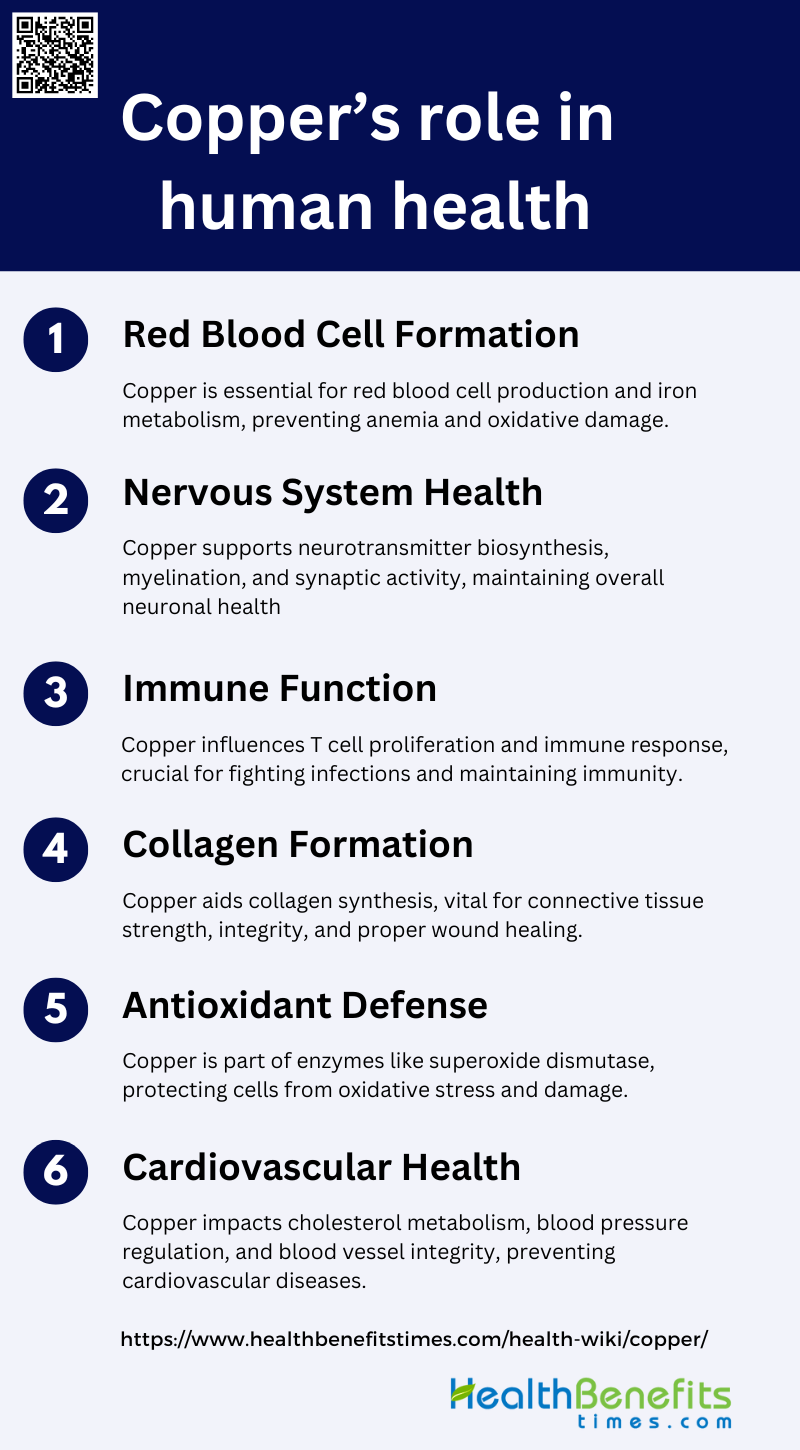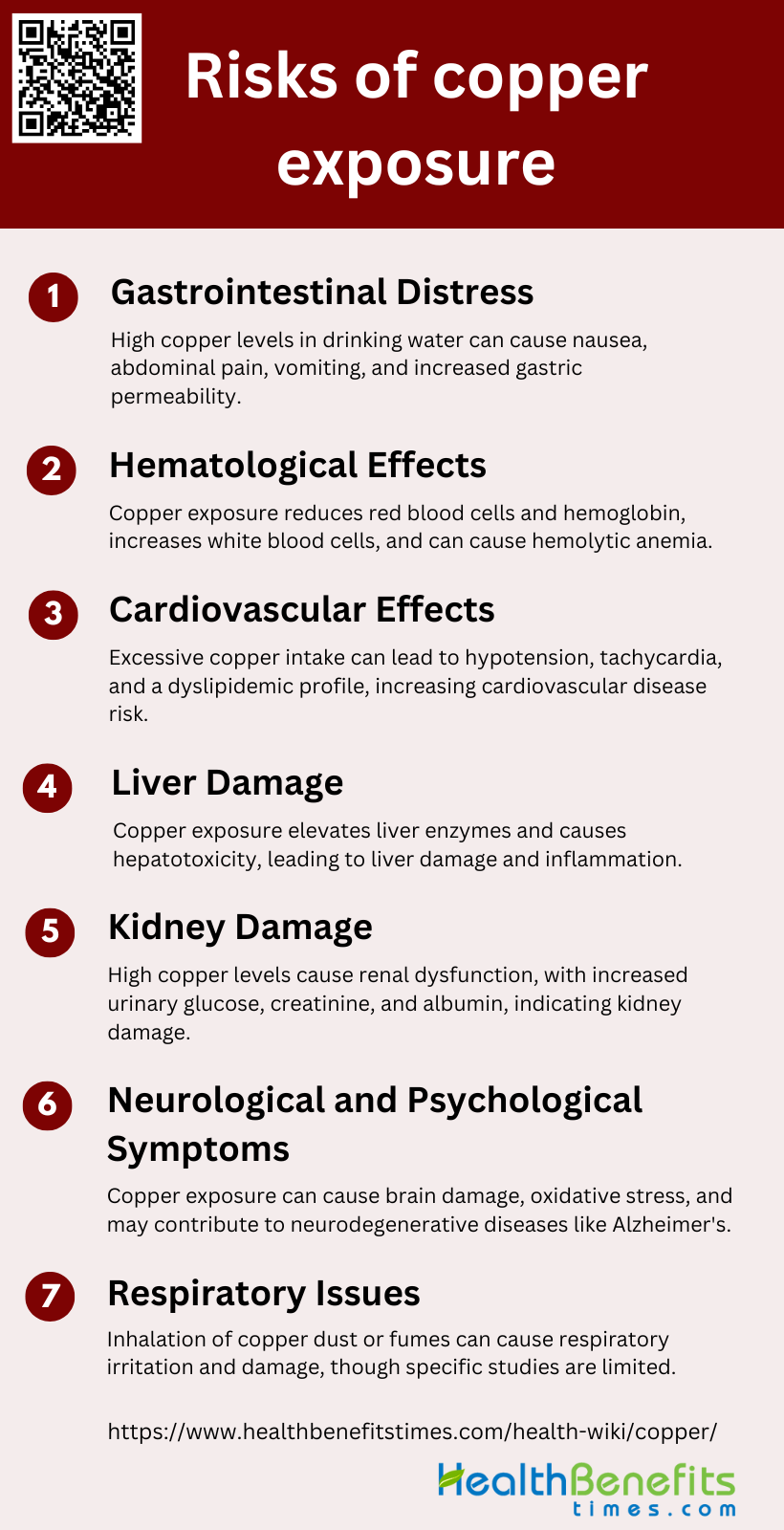Copper is a versatile and essential metallic element with the chemical symbol Cu and atomic number 29. It is a soft, malleable, and ductile metal with a distinctive reddish-orange color and excellent thermal and electrical conductivity. Copper has been used by humans for thousands of years, with applications ranging from ancient tools and decorative items to modern electrical wiring, plumbing, and electronic components. In nature, copper can be found in its pure form as native copper or in various minerals and ores. It is also an important trace element in biological systems, playing crucial roles in many enzymatic processes. Copper’s unique properties, including its corrosion resistance, antimicrobial effects, and ability to form alloys, make it invaluable in numerous industries, from construction and manufacturing to healthcare and renewable energy technologies.
Properties of Copper
Copper is a versatile metal with a wide range of applications due to its unique physical and chemical properties. Its distinct color, excellent conductivity, and reactivity make it valuable in various industries. Below are some key properties of copper:
1. Physical Properties
It has a density of 8920 kg/m³, making it relatively dense compared to other metals. Copper is highly valued for its excellent electrical and thermal conductivity, which are among the highest of any metal. This makes it an essential material in electrical wiring and electronic components. Additionally, copper’s ductility and malleability allow it to be easily shaped into various forms without breaking, further enhancing its utility in industrial applications. The metal’s attractive appearance and resistance to corrosion also contribute to its widespread use in decorative and architectural applications.
2. Chemical Properties
Copper exhibits a rich chemistry with multiple oxidation states, primarily Cu(0), Cu(I), and Cu(II), with Cu(II) being the most stable and common. The Cu(I) state is less stable and tends to disproportionate into Cu and Cu(II). Copper does not react with aqueous hydrochloric or sulfuric acids but is soluble in concentrated nitric acid due to its lower tendency to be oxidized. The metal’s ability to form various complexes, including those with organic molecules, is significant in both biological and industrial contexts. Copper’s reactivity is also harnessed in catalytic processes, where it can facilitate a range of organic transformations, including oxidation reactions. The metal’s role in biological systems is crucial, as it functions as a cofactor in enzymes that catalyze redox reactions, although its redox properties can also lead to toxicity if not properly regulated.
Types of Copper
Understanding the different types of copper can help in selecting the right material for specific needs. Below are some common types of copper:
1. Pure Copper
Pure copper is renowned for its exceptional electrical and thermal conductivity, making it a critical material in various industrial applications. Its face-centered cubic crystal structure contributes to its excellent ductility and corrosion resistance. Pure copper is refined through pyrometallurgical and hydrometallurgical techniques, ensuring high purity levels. Common forms of pure copper include oxygen-free copper, electrolytic tough-pitch copper, and phosphorous-deoxidized copper, each offering excellent drawability and specific properties suited to different applications. These characteristics make pure copper indispensable in electrical wiring, electronics, and high-precision engineering components.
2. High Copper Alloys
High copper alloys, which include compositions with significant copper content, are engineered to enhance specific properties such as strength, corrosion resistance, and electrical conductivity. Notable high-alloy systems include alpha and beta brasses, tin bronzes, aluminum bronzes, copper-nickel alloys, and beryllium coppers. These alloys are particularly valuable in applications requiring a balance of mechanical strength and conductivity, such as in cold-drawn wire used in electrical and structural applications. The mechanical properties of these alloys can be further improved through age hardening treatments, making them versatile for various industrial uses.
3. Copper Alloys
Copper alloys encompass a broad range of materials where copper is combined with other elements to achieve desired properties. These alloys are categorized based on their primary alloying elements, such as zinc in brasses, tin in bronzes, and nickel in copper-nickel alloys. Each category offers unique benefits; for instance, brasses are known for their machinability and corrosion resistance, while bronzes provide excellent wear resistance and strength. Copper alloys are extensively used in marine environments, electrical components, and mechanical engineering due to their tailored properties that meet specific application requirements.
4. Copper Tubing
Copper tubing is widely used in plumbing, heating, and cooling systems due to its excellent thermal conductivity, corrosion resistance, and ease of fabrication. It is available in various forms, including soft and hard-drawn tubes, which can be easily bent and joined using soldering or brazing techniques. The durability and reliability of copper tubing make it a preferred choice for water supply lines, refrigerant lines in HVAC systems, and gas distribution networks. Additionally, copper tubing’s antimicrobial properties contribute to its use in medical and food processing applications.
5. Copper Wire
Copper wire is a fundamental component in electrical and electronic systems due to its superior electrical conductivity and flexibility. It is used in power transmission, telecommunications, and electronic circuitry. The wire can be manufactured in various gauges and forms, including stranded and solid wire, to meet specific electrical and mechanical requirements. Copper wire’s high conductivity ensures minimal energy loss, making it ideal for efficient power distribution. Its ductility allows it to be drawn into thin wires without breaking, which is essential for intricate electronic applications.
6. Oxygen-Free Copper
Oxygen-free copper (OFC) is a high-purity form of copper that is refined to remove oxygen and other impurities. This type of copper is known for its superior electrical and thermal conductivity, making it ideal for high-performance applications such as in audio and video cables, superconductors, and high-vacuum electronic devices. The absence of oxygen in OFC prevents the formation of copper oxides, which can degrade conductivity and mechanical properties. This makes OFC particularly valuable in environments where high conductivity and reliability are critical.
Occurrence and Extraction of Copper
Natural Occurrence in the Earth’s Crust
Copper is commonly found in the Earth’s crust as copper-iron-sulfide and copper sulfide minerals, such as chalcopyrite (CuFeS2) and chalcocite (Cu2S). These minerals are typically present in low concentrations within ore bodies, with typical copper ores containing from 0.5% to 2% copper. The Earth’s crust holds significant stocks of copper, with estimates suggesting that around 0.25% of the copper in the crust has been concentrated into deposits over geological time. The natural repositories of copper in the Earth’s core, mantle, and crust hold much higher stocks of copper compared to anthropogenic repositories.
Main Sources of Copper
The primary sources of copper are porphyry copper deposits, which are shallow-level magmatic intrusions associated with thick magmatic arcs, such as those found in mature island arcs and continental arcs. These deposits are the most widespread and important sources of copper globally. Significant copper mining regions include the central Andes, which host numerous porphyry copper deposits formed when the continental arcs reached their maximum thickness. Additionally, the Kilembe copper mine in Western Uganda is an example of a historical copper mining site, although it has led to environmental concerns due to heavy metal contamination.
Methods of Extraction
Copper extraction from ores involves several methods, primarily concentration, smelting, and refining for sulfide ores, and heap leaching, solvent extraction, and electrowinning for oxide and chalcocite ores. Smelting involves heating the ore to a high temperature to separate the metal from impurities, followed by electrorefining to produce high-purity copper. Hydrometallurgical methods, such as heap leaching, use bacteria to oxidize sulfide minerals and produce sulfuric acid, which dissolves the copper for subsequent recovery by solvent extraction and electrowinning. Electrochemical processing, including electrorefining and electrowinning, is essential for producing high-purity copper. Innovative methods, such as using chicken dung leachate and aluminum electrodes, have also been explored for copper extraction.
Uses of Copper
Copper is an essential metal with a wide range of applications due to its excellent electrical and thermal conductivity, corrosion resistance, and malleability. It is used in various industries, from construction to electronics. Below are some common uses of copper:
1. Electrical and Electronics
Copper is extensively used in the electrical and electronics industry due to its excellent electrical conductivity. It is a primary material for electrical wiring, power transmission lines, and electronic components. The high conductivity of copper ensures efficient energy transfer, making it indispensable in the production of electrical equipment and devices. Additionally, copper’s thermal conductivity aids in heat dissipation, which is crucial for maintaining the performance and longevity of electronic devices.
2. Construction and Building
In the construction and building sector, copper is valued for its durability, malleability, and resistance to corrosion. It is commonly used in plumbing, roofing, and cladding. Copper pipes are preferred for water supply lines due to their longevity and resistance to bacterial growth. Moreover, copper’s aesthetic appeal and ability to form complex shapes make it a popular choice for architectural elements and decorative features.
3. Transportation
Copper plays a vital role in the transportation industry, particularly in the manufacturing of vehicles and aircraft. It is used in the production of electrical systems, motors, and wiring harnesses. Copper’s high conductivity and thermal properties are essential for the efficient operation of electric and hybrid vehicles. Additionally, copper alloys are used in brake systems and bearings, contributing to the safety and reliability of transportation systems.
4. Industrial Machinery and Equipment
In industrial machinery and equipment, copper is used for its excellent thermal and electrical conductivity. It is a key component in heat exchangers, refrigeration systems, and industrial motors. Copper’s ability to withstand high temperatures and its resistance to corrosion make it ideal for use in harsh industrial environments. Furthermore, copper alloys are used in the manufacturing of gears, bearings, and other critical machine components.
5. Telecommunications
Copper remains a fundamental material in the telecommunications industry. It is used in the production of cables and wiring for data transmission. Despite the rise of fiber optics, copper cables are still widely used for their reliability and ease of installation. Copper’s ability to transmit signals with minimal loss makes it suitable for both voice and data communication systems. Additionally, copper’s durability ensures long-lasting performance in telecommunications infrastructure.
6. Renewable Energy
Copper is crucial in the renewable energy sector, particularly in the production of solar panels, wind turbines, and energy storage systems. Its high electrical conductivity enhances the efficiency of energy generation and transmission. Copper is also used in the manufacturing of inverters and transformers, which are essential components of renewable energy systems. The shift towards sustainable energy sources has increased the demand for copper, highlighting its importance in achieving energy efficiency and reducing carbon emissions.
7. Medical and Healthcare
In the medical and healthcare sector, copper is recognized for its antimicrobial properties. Copper surfaces can rapidly kill bacteria, viruses, and fungi, making it an effective material for reducing healthcare-associated infections. It is used in hospital touch surfaces, such as door handles, bed rails, and medical equipment. The incorporation of copper in healthcare settings helps to maintain a hygienic environment and prevent the spread of infections.
8. Consumer Products
Copper is widely used in various consumer products due to its aesthetic appeal and functional properties. It is found in household items such as cookware, cutlery, and decorative pieces. Copper’s excellent heat conductivity makes it ideal for cooking utensils, ensuring even heat distribution. Additionally, copper’s antimicrobial properties make it a popular choice for kitchen and bathroom fixtures, contributing to a cleaner and safer home environment.
9. Agriculture
In agriculture, copper is used as a micronutrient in fertilizers and as a fungicide. It is essential for plant growth and development, playing a role in photosynthesis and enzyme activity. Copper-based fungicides help protect crops from fungal infections, ensuring healthy yields. Additionally, copper is used in animal feed to promote growth and prevent diseases in livestock. Its role in agriculture underscores its importance in maintaining food security and agricultural productivity.
10. Marine Applications
Copper and its alloys are extensively used in marine applications due to their resistance to corrosion and biofouling. They are used in the construction of ship hulls, propellers, and underwater piping. Copper-nickel alloys are particularly valued for their durability in seawater environments. The use of copper in marine applications helps to extend the lifespan of marine vessels and structures, reducing maintenance costs and improving operational efficiency.
11. Everyday Items
Copper is found in numerous everyday items, from coins and jewelry to musical instruments and household fixtures. Its malleability and attractive appearance make it a popular choice for decorative and functional objects. Copper’s antimicrobial properties also make it suitable for use in frequently touched items, such as door handles and light switches, contributing to a healthier living environment. The versatility of copper ensures its presence in a wide range of daily-use products.
Copper’s role in human health
Copper is an essential trace mineral vital for various bodily functions. It plays a crucial role in maintaining a healthy immune system, producing energy, and forming red blood cells. Here are some key benefits of copper for human health:
1. Red Blood Cell Formation
Copper deficiency can lead to anemia, characterized by reduced RBC production and impaired iron utilization. Studies have shown that copper is necessary for the activity of enzymes involved in erythropoiesis, the process of RBC formation. Supplementation with copper has been demonstrated to improve RBC oxidizability and protect against oxidative damage, further underscoring its importance in maintaining healthy RBC levels.
2. Nervous System Health
It is involved in neurotransmitter biosynthesis, myelination, and modulation of synaptic activity. Both copper deficiency and excess can lead to neurological disorders, highlighting the need for balanced copper homeostasis. Copper’s role in the nervous system includes participation in cellular respiration, peptide amidation, and the prevention of excitotoxic cell death, which is vital for maintaining neuronal health and function.
3. Immune Function
Copper is integral to the immune system, influencing various immune responses. It is involved in the proliferation of T cells and the production of interleukin 2, which are critical for immune function. Copper deficiency can lead to reduced neutrophil counts and impaired ability to generate superoxide anion, which is essential for killing ingested microorganisms. Even marginal copper deficiency can adversely affect immune responses, indicating the importance of adequate copper levels for maintaining immune health.
4. Collagen Formation
Copper is a key component in the synthesis of collagen, a structural protein essential for connective tissue strength and integrity. It acts as a cofactor for lysyl oxidase, an enzyme that catalyzes the crosslinking of collagen and elastin, thereby providing structural stability to tissues. Copper deficiency can result in weakened connective tissues, leading to conditions such as skin fragility and poor wound healing. Ensuring sufficient copper intake is crucial for maintaining healthy collagen levels and overall tissue health.
5. Antioxidant Defense
Copper contributes to the body’s antioxidant defense mechanisms by being a part of enzymes like superoxide dismutase (SOD), which neutralizes harmful free radicals. Copper deficiency can impair oxidative defense, leading to increased susceptibility to oxidative stress and related diseases. Studies have shown that copper supplementation can enhance the resistance of red blood cells to oxidative damage, further emphasizing its role in protecting cells from oxidative stress.
6. Cardiovascular Health
Copper is vital for cardiovascular health, influencing various aspects such as cholesterol metabolism, blood pressure regulation, and the integrity of blood vessels. Copper deficiency has been linked to hypercholesterolemia, hypertension, and impaired prostaglandin metabolism, all of which can contribute to cardiovascular diseases. Research indicates that maintaining adequate copper levels is essential for preventing heart diseases and ensuring the proper functioning of the cardiovascular system.
Dietary sources of copper
Copper is a vital trace mineral necessary for various bodily functions, including energy production, immune support, and the formation of red blood cells. Here are the dietary sources of copper:
- Organ Meats: Liver, particularly beef liver, is one of the richest sources of copper, providing more than 18 times the daily value per serving.
- Shellfish: Oysters, lobsters, and crabs are excellent sources of copper. For example, oysters offer 7.6 mg of copper per 100 grams, which is 844% of the daily recommended intake.
- Nuts and Seeds: Nuts like cashews and almonds, as well as seeds such as sesame and sunflower seeds, are high in copper. One ounce of cashews provides 67% of the daily recommended intake.
- Leafy Greens: Vegetables like spinach, kale, and Swiss chard are good plant-based sources of copper. Cooked Swiss chard, for instance, provides 33% of the daily recommended intake per cup.
- Mushrooms: Shiitake mushrooms are particularly high in copper, with a handful providing nearly all of your daily needs. Other varieties like oyster and portobello mushrooms also contain significant amounts of copper.
Recommended daily intake and supplements of Copper
The recommended daily intake of copper varies by age, gender, and physiological status. For adults, the Adequate Intakes (AIs) are set at 1.6 mg/day for men and 1.3 mg/day for women, based on mean observed intakes in several European Union countries. For children, the AIs range from 0.7 mg/day for those aged 1 to <3 years to 1.3 mg/day for boys and 1.1 mg/day for girls aged 10 to <18 years. Pregnant and lactating women have an increased AI of 1.5 mg/day to account for the additional copper needed for fetal development and lactation. Copper supplementation can be beneficial, particularly in populations at risk of deficiency, such as the elderly and pregnant women, where dietary intake alone may not meet the recommended levels. However, it is important to note that excessive intake of other minerals like zinc can interfere with copper absorption, highlighting the need for balanced supplementation. Additionally, copper supplementation has shown potential benefits in bone metabolism, suggesting it may help in slowing down bone mineral loss and reducing resorption markers.
Risks of copper exposure
Copper is an essential trace mineral necessary for various bodily functions, but excessive exposure can lead to adverse health effects. Overexposure to copper can occur through contaminated water, dietary supplements, or occupational hazards. Here are some key risks associated with copper exposure:
1. Gastrointestinal Distress
Copper exposure can lead to significant gastrointestinal distress. In a study involving healthy adult women, ingestion of drinking water with added copper at concentrations of 3 mg/L and 5 mg/L resulted in symptoms such as nausea, abdominal pain, and vomiting. These symptoms were significantly more frequent compared to lower concentrations of copper, indicating a dose-dependent relationship. Another study found that acute ingestion of copper increased gastric permeability, which could contribute to gastrointestinal symptoms. These findings suggest that high levels of copper in drinking water can cause acute gastrointestinal issues.
2. Hematological Effects
Copper exposure has been shown to affect hematological parameters. In a study on major carp (Catla catla), exposure to copper resulted in a significant decrease in red blood cells (RBCs), hemoglobin (Hb), and hematocrit (Hct), while increasing the total white blood cell count and neutrophil population. Another study highlighted that copper sulfate ingestion could lead to hemolysis and hemolytic anemia, particularly in individuals with genetic susceptibilities such as Wilson’s disease. These hematological changes indicate that copper can adversely affect blood cell counts and function.
3. Cardiovascular Effects
Copper exposure can also impact the cardiovascular system. A case study of copper sulfate poisoning reported systemic effects on the cardiovascular system, including hypotension and tachycardia. Additionally, a study on diabetic rats found that high copper intake led to a dyslipidemic profile, characterized by increased cholesterol and LDL-cholesterol levels, which are risk factors for cardiovascular diseases. These findings suggest that excessive copper intake can have detrimental effects on cardiovascular health.
4. Liver Damage
Liver damage is a significant risk associated with copper exposure. A study on Sprague-Dawley rats found that early-life exposure to copper significantly increased levels of liver enzymes such as ALT, AST, and ALP, indicating liver damage. Another study using human liver carcinoma cells showed that copper exposure led to hepatotoxicity, characterized by hepatic necrosis and the induction of stress genes related to inflammation and oxidative stress. These studies highlight the potential for copper to cause liver damage through various mechanisms.
5. Kidney Damage
Copper exposure can also lead to kidney damage. In a study on diabetic rats, high copper intake resulted in increased urinary glucose, creatinine, and albumin levels, indicating renal dysfunction. Another study on major carp exposed to copper showed histopathological changes in the kidneys, including atrophy of glomeruli and necrosis of renal tubular cells. These findings suggest that copper can induce renal toxicity, particularly in individuals with pre-existing conditions like diabetes.
6. Neurological and Psychological Symptoms
Copper exposure has been linked to neurological and psychological symptoms. A study on Sprague-Dawley rats exposed to copper, manganese, and mercury found significant histopathological changes in the brain, including axonal damage and chromatin condensation, which are indicative of oxidative stress. Another review discussed the potential role of copper in Alzheimer’s disease, suggesting that copper dyshomeostasis and its interaction with amyloid-beta could contribute to neurotoxicity. These studies indicate that copper exposure can adversely affect neurological function and may be linked to neurodegenerative diseases.
7. Respiratory Issues
While the provided data does not directly address respiratory issues related to copper exposure, it is known that inhalation of copper dust or fumes can cause respiratory irritation and damage. Copper sulfate ingestion has been reported to cause systemic effects, including those on the respiratory system, although specific respiratory symptoms were not detailed in the provided studies. Further research is needed to elucidate the respiratory risks associated with copper exposure.
Environmental Impact and Recycling of Copper
Copper mining poses significant environmental concerns, including habitat destruction, soil and water contamination, and high energy consumption, which contribute to global warming and human toxicity. Recycling copper is crucial as it alleviates the pressure on natural resources and significantly reduces environmental impacts. For instance, the environmental impact of secondary copper production is only one-eighth that of primary copper production. Various methods of recycling, such as hydrometallurgical and pyrometallurgical processes, have been developed to efficiently recover copper from waste materials, including E-waste and copper slag. These methods not only conserve energy but also reduce pollution and the need for new mining activities, thus promoting a more sustainable and circular economy. The benefits of recycling copper extend beyond environmental protection to economic gains, as it is often more cost-effective than extracting copper from virgin ores. Therefore, enhancing copper recycling practices is essential for mitigating the adverse environmental impacts of copper mining and fostering sustainable resource management.
Economic Significance of Copper
Copper plays a pivotal role in the global economy due to its extensive use in various industries, including construction, electronics, and renewable energy. Major producers of copper include Chile, which accounts for approximately 28.3% of global production, and Russia, which is also a significant player in the market. On the consumption side, China stands out as the largest consumer, driven by its rapid industrialization and urbanization, followed by other Asian countries and the United States. Market trends indicate a steady increase in global copper consumption, particularly in developing countries like China and India, which are expected to drive demand in the coming decades. The future outlook for copper remains positive, with anticipated growth in demand due to advancements in green technologies and increased electrification, although supply constraints and the need for sustainable practices pose challenges.


